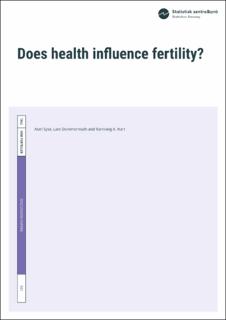| dc.contributor.author | Syse, Astri | |
| dc.contributor.author | Dommermuth, Lars | |
| dc.contributor.author | Hart, Rannveig Kaldager | |
| dc.coverage.spatial | Norway | en_US |
| dc.date.accessioned | 2020-04-22T10:14:29Z | |
| dc.date.available | 2020-04-22T10:14:29Z | |
| dc.date.issued | 2020-02 | |
| dc.identifier.issn | 1892-753X | |
| dc.identifier.uri | https://hdl.handle.net/11250/2652054 | |
| dc.description | This work is jointly financed by the Ministry of Health and Care Services, Ministry of Children and Families, Ministry of Labour and Social Affairs and the Ministry of Education and Research in Norway, through a grant to the Norwegian Institute of Public Health. Hart’s contribution is partly supported by the Research Council of Norway through its Centres of Excellence funding scheme, project number 262700. | en_US |
| dc.description.abstract | Poor health may constrain women’s capacity for active leisure, including family life and childrearing, for participation in the labor market and potentially affect preferences. Still, health remains remarkably understudied as a fertility determinant. We explore the association between health and fertility, using uptake of doctor-certified sickness absences and long-term health-related benefits as proxies for health. We examine whether compositional changes in health distributions and/or changes in the health-fertility association have contributed to the distinct fall in the total fertility rate in Norway since 2009. We use nationwide registry data on women aged 16-45 from 2004-2018. We analyse first, second and third births separately, and use annual observations with lagged timevarying covariates for education, sickness absence and long-term benefits. Income, employment and partnership status are also included in some subanalyses.
Long-term benefit uptake is negatively associated with fertility, and the association weakens over time. In addition, such uptake is relatively rare, but increases slightly over time. The use of sickness absence is positively associated with fertility, and the association strengthens over time. Sickness absence uptake is common but decreases over time. It is thus unlikely that changes in women’s health and/or changes in the health-fertility association can help explain the observed decline in fertility observed after 2009. However, if the decrease in sickness absence uptake reflects a stronger labor market preference among women in fertile ages, it might help explain parts of the observed decline. Overall, the decline in fertility is most pronounced for healthy women. Health as a fertility determinant warrants further research, from other countries and with other proxies for health. | en_US |
| dc.language.iso | eng | en_US |
| dc.publisher | Statistisk sentralbyrå | en_US |
| dc.relation.ispartofseries | Discussion Paper;No. 921 | |
| dc.rights | Attribution-NonCommercial-NoDerivatives 4.0 Internasjonal | * |
| dc.rights.uri | http://creativecommons.org/licenses/by-nc-nd/4.0/deed.no | * |
| dc.subject | Fertility | en_US |
| dc.subject | Fruktbarhet | en_US |
| dc.subject | Health | en_US |
| dc.subject | Helse | en_US |
| dc.subject | Sick leave | en_US |
| dc.subject | Sykefravær | en_US |
| dc.subject | Total fertility rate | en_US |
| dc.subject | Fruktbarhetsrater | en_US |
| dc.title | Does health influence fertility? | en_US |
| dc.type | Working paper | en_US |
| dc.source.pagenumber | 36 | en_US |
| dc.relation.project | Norges Forskningsråd: 262700 | en_US |

